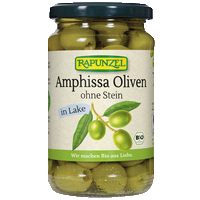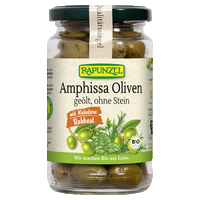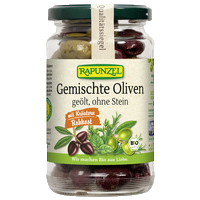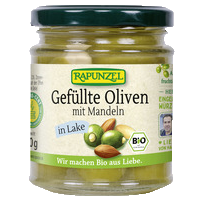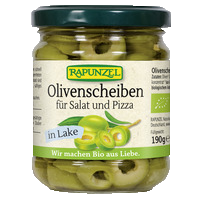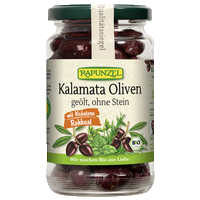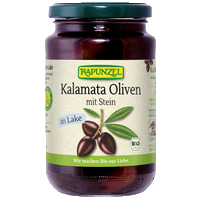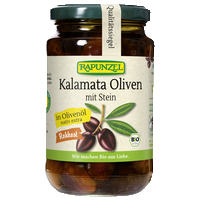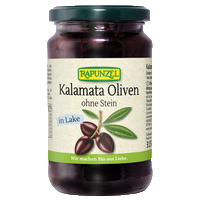Rapunzel Products Antipasti & spice pastes
A visit to the Rapunzel olive grower in Greece
Fine Kalamata olives – a gift from the Greek gods
A visit to the Rapunzel olive grower in Greece
Rapunzel’s fine Kalamata olives are grown in Laconia, a mountainous region in the south of Greece. The olive grove is home to olive trees that are hundreds of years old, gnarled figures with many stories to tell. When you allow your gaze to wander, you will discover the ruins of the Byzantine city of Mystras. And further behind, you can see the snow-covered peaks of Tayegetos.
The soil
Here, the olive farmer Efthemios owns a total of about 7,000 olive trees on a surface of 30 hectares. A large share of these are Koroneiki olives, from which the mild and fruity Manira olive oil is extracted.
Wood sorrel’s shiny yellow blossoms peek through the gnarled olives. Together with other plants as undergrowth, the clover ensures soil fertility. The plants are carefully selected, depending on the respective soil quality. This green manuring remains in place after cutting, thereby preventing the soil from drying out.
The olive trees are pruned after the harvest. In contrast to conventional farmers, organic farmers utilise this green waste: It is finely chopped and then spread out underneath the trees. This loosens the soil and makes it permeable, also in the event of heavy rainfall. And it's also good for one of the farmers' best friends: "The earthworms are my best workers. I want them to feel right at home here," says Michalis, who is an agricultural engineer.
Here, the olive farmer Efthemios owns a total of about 7,000 olive trees on a surface of 30 hectares. A large share of these are Koroneiki olives, from which the mild and fruity Manira olive oil is extracted.
Wood sorrel’s shiny yellow blossoms peek through the gnarled olives. Together with other plants as undergrowth, the clover ensures soil fertility. The plants are carefully selected, depending on the respective soil quality. This green manuring remains in place after cutting, thereby preventing the soil from drying out.
The olive trees are pruned after the harvest. In contrast to conventional farmers, organic farmers utilise this green waste: It is finely chopped and then spread out underneath the trees. This loosens the soil and makes it permeable, also in the event of heavy rainfall. And it's also good for one of the farmers' best friends: "The earthworms are my best workers. I want them to feel right at home here," says Michalis, who is an agricultural engineer.

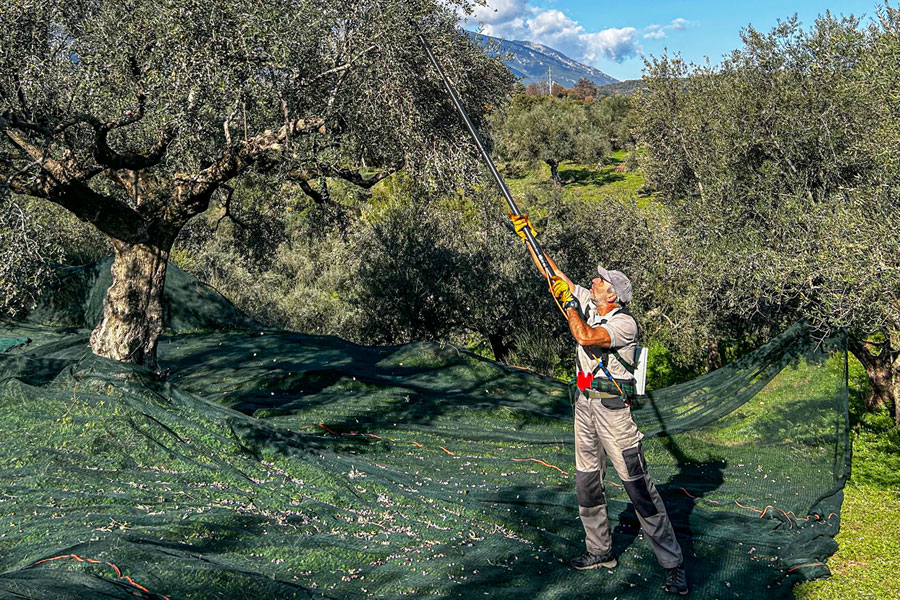
The harvest
The green to light purple olive harvest, which is used for olive oil, is already over. Now, in January, the time has come for the thick-fleshed, fully-ripened Kalamata olives.
The olives are harvested by hand: The helpers use electric rakes to strip the olives from the branches. The olives fall into a net – ensuring they remain intact. A machine separates the olives from the leaves and small twigs right on site. Immediately after harvesting, the olives are sent to our supplier's processing plant.
The green to light purple olive harvest, which is used for olive oil, is already over. Now, in January, the time has come for the thick-fleshed, fully-ripened Kalamata olives.
The olives are harvested by hand: The helpers use electric rakes to strip the olives from the branches. The olives fall into a net – ensuring they remain intact. A machine separates the olives from the leaves and small twigs right on site. Immediately after harvesting, the olives are sent to our supplier's processing plant.
The ripening process
The olive processing plant is located near Kalamata. Both the black Kalamata olives from Laconia and the green Amphissa olives from central Greece are processed here.
Then a months-long ripening process starts after washing and cleaning the olives: Firstly, the fruit is debittered in water with a little salt. The salt content is then increased, little by little. It is important to ensure the controlled start and process of lactic acid fermentation. To achieve this, employees repeatedly test the salt and pH values in the ripening vats.
After this ripening process, the olives are once again washed and carefully sorted by hand: Is the colour right? Are the olives undamaged? The rejects are not disposed of but processed further, among others, into olive paste.
The olive processing plant is located near Kalamata. Both the black Kalamata olives from Laconia and the green Amphissa olives from central Greece are processed here.
Then a months-long ripening process starts after washing and cleaning the olives: Firstly, the fruit is debittered in water with a little salt. The salt content is then increased, little by little. It is important to ensure the controlled start and process of lactic acid fermentation. To achieve this, employees repeatedly test the salt and pH values in the ripening vats.
After this ripening process, the olives are once again washed and carefully sorted by hand: Is the colour right? Are the olives undamaged? The rejects are not disposed of but processed further, among others, into olive paste.
The processing
Careful inspection ensures that all pits have been removed. For this purpose, the olives are placed in a salt water basin. The heavy olives, with pit, sink to the bottom, while the pitted olives float to the top. These are skimmed off and processed further. Depending on the variety, the olives are mixed with herbs and olive oil, after which they are filled into jars.
The production of the stuffed green Amphissa olives is particularly labour-intensive: The employees individually fill each olive by hand, for example with almonds. They are so skilful, they can do it in a flash.
Careful inspection ensures that all pits have been removed. For this purpose, the olives are placed in a salt water basin. The heavy olives, with pit, sink to the bottom, while the pitted olives float to the top. These are skimmed off and processed further. Depending on the variety, the olives are mixed with herbs and olive oil, after which they are filled into jars.
The production of the stuffed green Amphissa olives is particularly labour-intensive: The employees individually fill each olive by hand, for example with almonds. They are so skilful, they can do it in a flash.
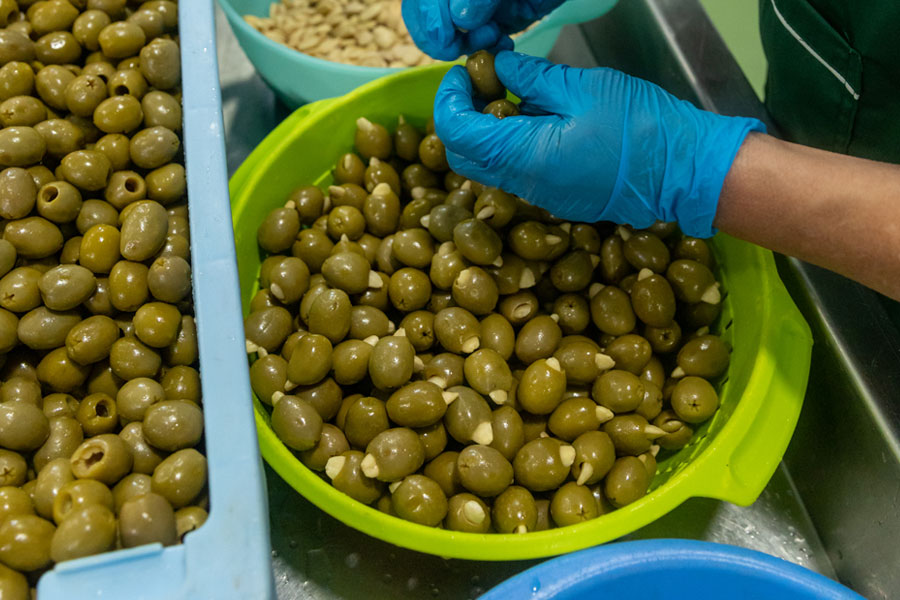
The bottling
Now the delicacies have to go into the jar. Here, care and manual labour are also required on the conveyor belt. Each jar is weighed to ensure that not too few olives end up in the jar. Before the employee places the jars on the pallet, each jar is wiped with a soft cloth. So much work goes into every single olive.
Or, simply stated: "There is so much love in every product, so many hands work on it," says employee Eugenia. "Like Rapunzel, we also make organic out of love."
Now the delicacies have to go into the jar. Here, care and manual labour are also required on the conveyor belt. Each jar is weighed to ensure that not too few olives end up in the jar. Before the employee places the jars on the pallet, each jar is wiped with a soft cloth. So much work goes into every single olive.
Or, simply stated: "There is so much love in every product, so many hands work on it," says employee Eugenia. "Like Rapunzel, we also make organic out of love."

